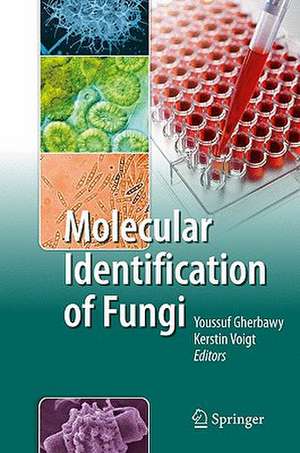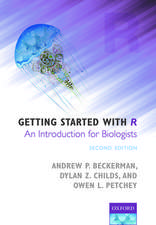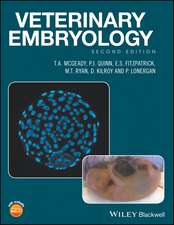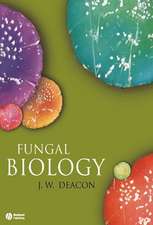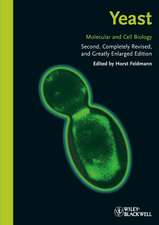Molecular Identification of Fungi
Editat de Youssuf Gherbawy, Kerstin Voigten Limba Engleză Hardback – 11 mar 2010
This timely book links scientists from different parts of the world who are interested in the molecular identification of fungi combined with the exploration of the fungal biodiversity in different ecosystems. It provides a compendium for scientists who rely on a rapid and reliable detection of fungal specimens in environmental as well as clinical resources in order to ensure the benefit of industrial and clinical applications.
Chapters focus on the opportunities and limits of the molecular marker-mediated identification of fungi. Various methods, procedures and strategies are outlined. Furthermore, the book offers an update of the current progress in the development of fungal molecular techniques, and draws attention to potential and associated problems, as well as integrating theory and practice.
| Toate formatele și edițiile | Preț | Express |
|---|---|---|
| Paperback (1) | 1227.52 lei 6-8 săpt. | |
| Springer Berlin, Heidelberg – 14 noi 2014 | 1227.52 lei 6-8 săpt. | |
| Hardback (1) | 1232.26 lei 6-8 săpt. | |
| Springer Berlin, Heidelberg – 11 mar 2010 | 1232.26 lei 6-8 săpt. |
Preț: 1232.26 lei
Preț vechi: 1502.76 lei
-18% Nou
Puncte Express: 1848
Preț estimativ în valută:
235.82€ • 245.89$ • 195.99£
235.82€ • 245.89$ • 195.99£
Carte tipărită la comandă
Livrare economică 21 martie-04 aprilie
Preluare comenzi: 021 569.72.76
Specificații
ISBN-13: 9783642050411
ISBN-10: 3642050417
Pagini: 524
Ilustrații: XXII, 501 p.
Dimensiuni: 155 x 235 x 37 mm
Greutate: 0.86 kg
Ediția:2010
Editura: Springer Berlin, Heidelberg
Colecția Springer
Locul publicării:Berlin, Heidelberg, Germany
ISBN-10: 3642050417
Pagini: 524
Ilustrații: XXII, 501 p.
Dimensiuni: 155 x 235 x 37 mm
Greutate: 0.86 kg
Ediția:2010
Editura: Springer Berlin, Heidelberg
Colecția Springer
Locul publicării:Berlin, Heidelberg, Germany
Public țintă
ResearchCuprins
Plant Pathological and Environmental Biological Aspects.- Fungal Pathogens of Plants in the Homogocene.- Molecular Techniques for Classification and Diagnosis of Plant Pathogenic Oomycota.- Plasmodiophorids: The Challenge to Understand Soil-Borne, Obligate Biotrophs with a Multiphasic Life Cycle.- Applications of Molecular Markers and DNA Sequences in Identifying Fungal Pathogens of Cool Season Grain Legumes.- Quantitative Detection of Fungi by Molecular Methods: A Case Study on Fusarium.- DNA-Based Tools for the Detection of Fusarium spp. Pathogenic on Maize.- Molecular Detection and Identification of Fusarium oxysporum.- Molecular Chemotyping of Fusarium graminearum, F. culmorum, and F. cerealis Isolates From Finland and Russia.- Molecular Characterization and Diagnosis of Macrophomina phaseolina: A Charcoal Rot Fungus.- Molecular Diagnosis of Ochratoxigenic Fungi.- Molecular Barcoding of Microscopic Fungi with Emphasis on the Mucoralean Genera Mucor and Rhizopus.- Advances in Detection and Identification of Wood Rotting Fungi in Timber and Standing Trees.- Molecular Diversity and Identification of Endophytic Fungi.- Molecular Identification of Anaerobic Rumen Fungi.- Human Pathological and Clinical Aspects.- New Approaches in Fungal DNA Preparation from Whole Blood and Subsequent Pathogen Detection Via Multiplex PCR.- Classification of Yeasts of the Genus Malassezia by Sequencing of the ITS and D1/D2 Regions of DNA.- DNA-Based Detection of Human Pathogenic Fungi: Dermatophytes, Opportunists, and Causative Agents of Deep Mycoses.- Applications of Loop-Mediated Isothermal Amplificaton Methods (LAMP) for Identification and Diagnosis of Mycotic Diseases: Paracoccidioidomycosis and Ochroconis gallopava infection.- Identification of the Genus Absidia (Mucorales, Zygomycetes): A Comprehensive Taxonomic Revision.- Molecular Characters of Zygomycetous Fungi.
Recenzii
From the reviews:
“This book is about using molecular techniques for identification of fungi. … The book is well laid out but has few good illustrations and each chapter is provided by a special topic, so the reader can go through separately and easily. All chapters are well referenced and indexed at the back of the book. The book should be available in all university and public libraries, and research laboratories especially those who are interested in molecular phylogenetics.” (Jian-Kui Liu, Fungal Diversity, April, 2012)
“This book is about using molecular techniques for identification of fungi. … The book is well laid out but has few good illustrations and each chapter is provided by a special topic, so the reader can go through separately and easily. All chapters are well referenced and indexed at the back of the book. The book should be available in all university and public libraries, and research laboratories especially those who are interested in molecular phylogenetics.” (Jian-Kui Liu, Fungal Diversity, April, 2012)
Caracteristici
Highlights the applications of molecular techniques in basic and applied mycology Elaborately illustrated including more than 30 colour figures and many other exemplifications Includes supplementary material: sn.pub/extras
